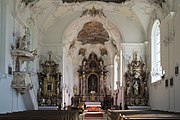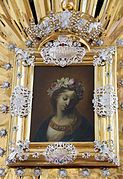St. Johannes Baptist (Wessobrunn)
The Catholic parish church of St. Johannes Baptist in Wessobrunn , a community in the Upper Bavarian district of Weilheim-Schongau , was built in the 1750s on the site of various previous buildings according to plans by Joseph Schmuzer and his son Franz Xaver in the Rococo style. The church stands north of the bell and defense tower of the demolished Wessobrunn monastery church . The stucco decoration comes from Tassilo Zöpf , the frescoes were done by Johann Baptist Baader .
architecture
The structure of the church of St. Johannes Baptist corresponds to a typical hall church built by the Wessobrunn master builders . The choir and nave are covered by barrels of stab cap. The walls are divided into double pilasters , which are decorated with capitals and crowned by entablature . The retracted choir is closed in a semicircle. The western end of the nave forms a double empore , on the upper gallery, there is organ installed. A roof turret with an onion hood rises above the west facade .
Piece
The Rococo stucco is an early work by Tassilo Zöpf . Rocaille cartouches cover the ceilings of the choir and the nave and frame the smaller frescoes. In a stucco cartouche on the choir arch you can see the coat of arms of the Wessobrunn abbot Beda Schallhammer, who commissioned the church. Two angels putt around the coat of arms, one holding the abbot's staff , the other the miter . A gilded angel bust above the coat of arms bears the miter on the head.
Ceiling frescoes
The ceiling frescoes created in 1758/59 bear the signature of Johann Baptist Baader several times . The painter, who comes from Lechmühlen, now part of the municipality of Fuchstal , is also known under the name "Lechhansl".
The large ceiling fresco in the choir shows visions from the Revelation of John of Patmos . In the center you can see a crescent Madonna , on the left an angel plunges a monster into the depths. Below is the evangelist John with his attribute , the eagle. The author of the Revelation, John of Patmos, is often mistakenly equated with the evangelist John. The cartouches on the side show the four Latin church fathers with their attributes. Saint Jerome is depicted as a penitent with a skull, around the head of Pope Gregory the Great hovers a dove, Augustine holds a burning heart in his hand and next to Bishop Ambrose you can see a miter.
The fresco in the nave is dedicated to John the Baptist, the patron saint of the church, and depicts episodes from his life. John stands in front of Herod , John sits in a dungeon and John is beheaded. Almost half of the picture is taken up by the baptism of Jesus , above which angels carry a banner with the inscription: "HIC EST FILIUS MEUS DILECT IN QUO MIHI BENE COMPLACUI" (this is my beloved son, in whom I am pleased). The smaller side frescoes are emblematic representations that refer to John as a preacher in the desert and as a forerunner of Jesus.
Furnishing
- The late Romanesque four-nail crucifix on the north wall of the nave is dated around 1220. It is designed as a branch cross and was renewed in the 16th century.
- The Romanesque baptismal font probably comes from the first parish church in Wessobrunn, which was built around 1128.
- The pulpit was created as the altars of Tassilo Zöpf.
- The altar panel of the four-column high altar was made by Johann Baptist Baader and depicts the crucifixion of Christ. The two figures on the side, John the Evangelist on the left and John the Baptist on the right, are by Franz Xaver Schmädl .
- The miraculous image of the Mother of Beautiful Love is integrated in the left side altar . It was painted in 1706 by the monk Innocent Metz of the former Benedictine AbbeyChecking .
- In the middle of the south side altar is a sculpture of St. Agatha , who holds a bowl on which her breasts lie. The figure from 1759 comes from Franz Xaver Schmädl. Saint Agatha was venerated as a patron saint by the Wessobrunn artists.
organ
The organ is on the upper gallery. Today's instrument was built in 1990 by the organ builder Maximilian Offner from Kissing in the preserved early classical monument prospectus of the Wessobrunn organ builder Jakob Kölbl. The abrasive loading -instrument with mechanical play and key action has 21 registers , on two manuals and pedals are distributed.
The disposition is as follows:
|
|
|
||||||||||||||||||||||||||||||||||||||||||||||||||||||||||||||||||||||||||
- Coupling : II / I, I / P, II / P
literature
- Georg Dehio : Handbook of German Art Monuments - Bavaria IV - Munich and Upper Bavaria . 2nd edition, Deutscher Kunstverlag, Munich 2002, ISBN 3-422-03010-7 , p. 1274.
- Hans Rohrmann: Wessobrunn. Parish of St. John Baptist . Kunstverlag Josef Fink, Lindenberg 2016, ISBN 978-3-89870-992-7 .
- Georg Paula , Stefanie Berg-Hobohm : District Weilheim-Schongau (= Bavarian State Office for Monument Preservation [Hrsg.]: Monuments in Bavaria . Volume I.23 ). Lipp, Munich 2003, ISBN 3-87490-585-3 , pp. 617-621 .
Web links
Individual evidence
- ↑ St. Johannes Baptist, Diocese of Augsburg , bistum-augsburg.de, accessed on December 25, 2017.
- ↑ Orgeldatenbank Bayern online , gfbm.wn.de, accessed on December 25, 2017.
- ^ Wessobrunn, St. Johann Baptist - organindex, the free organ database. In: organindex.de. October 5, 2017. Retrieved December 25, 2017 .
Coordinates: 47 ° 52 ′ 39.5 " N , 11 ° 1 ′ 34.4" E















